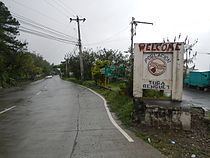Barangays Area 296 km² | Founded 1911 Time zone PST (UTC+8) Local time Sunday 12:18 PM | |
 | ||
District Lone District of Benguet Weather 24°C, Wind S at 3 km/h, 70% Humidity Neighborhoods Tabaan, Nangalisan, Camp 3, Buebue Points of interest Ben Cab Museum, Dinosaurs Island, Mount Ulap, Mount Cabuyao, Bridal Veil falls - Baguio City | ||
Tuba, officially the Municipality of Tuba (Ilocano: Ili ti Tuba; Filipino: Bayan ng Tuba), is a municipality in the province of Benguet in the Cordillera Administrative Region (CAR) of the Philippines. The population was 47,648 at the 2015 census. In the 2016 electoral roll, it had 23,210 registered voters.
Contents
- Map of Tuba Benguet Philippines
- History
- Geography
- Topography
- Climate
- Barangays
- Demographics
- Economy
- Public schools
- Transportation
- References
Map of Tuba, Benguet, Philippines
Tuba is known as the "Gateway to Baguio", as the Ben Palispis Highway and Kennon Road, two main access highways of the adjacent city of Baguio, are largely traversed in the municipality.
History
Tuba was originally a barrio of the township of Baguio in the early 1900s under the American Occupation of the Philippines. It was separated from Baguio upon the latter's conversion into a chartered city on September 1, 1909, and became part of the township of Twin Peaks in Benguet.
Twin Peaks was abolished as a township on December 11, 1911 with the issuance of Executive Order No. 77 by American Governor General William Cameron Forbes, creating the township of Tuba.
On June 25, 1963, President Diosdado Macapagal issued Executive Order No. 42 and by operation of Section 2 of Republic Act No. 1515, the municipal District of Tuba was converted into a regular municipality.
Geography
Tuba is located at 16°19′N 120°33′E, at the south-western tip of both Benguet and the Central Cordillera Mountain Range. South of the municipality lies the province of Pangasinan and to the west lies the Ilocos rolling hills of the province of La Union. It is bordered on the north by Sablan and La Trinidad; east by Baguio and Itogon; and south by Sison and San Manuel.
According to the Philippine Statistics Authority, the municipality has a land area of 295.97 square kilometres (114.27 sq mi) constituting 7001106900000000000♠10.69% of the 2,769.08-square-kilometre- (1,069.15 sq mi) total area of Benguet.
The municipality's urban area comprises the barangays of Poblacion and Camp 3, having a composite land area of 83.85 square kilometres (32.37 sq mi), or 19.31% of the total land area.
Topography
Tuba's topography is generally characterized by irregular rugged terrain and steep slopes with several mountain peaks rising from the table land itself. Mount Santo Tomas, the highest peak in the municipality soars to 2,252 metres (7,388 ft) above sea level.
Four major rivers/streams and 49 tributary/minor rivers and creeks intersect the landform and serve as the drains of the municipality.
Climate
Tuba has 2 pronounced seasons - wet and dry. The dry season starts in November and lasts until April while the wet season lasts from May to October.
Barangays
Tuba is politically subdivided into 13 barangays.
Demographics
In the 2015 census, Tuba had a population of 47,648. The population density was 160 inhabitants per square kilometre (410/sq mi).
In the 2016 electoral roll, it had 23,210 registered voters.
Economy
Mining is a major contributor to the economy of Tuba. The town's mining industry began upon the discovery of gold in the province of Benguet during the early 1930s. Since 1958, Philex Mining Corporation, the largest gold and copper producer in the Philippines, has been operating the first underground block cave mine in the Far East at Padcal in Barangay Camp 3.
A few abandoned mining sites such as those of Benguet Exploration Mine and Black Mountain, Inc. have been left unattended for years, which pose a threat to the local population and the environment.
The presence of waterfalls, hot springs and natural caves in the municipality boosts tourism. Mount Cabuyao and Mount Santo Tomas, the highest mountain in the town, are frequently visited by mountaineers.
Public schools
As of 2014, Tuba has 32 public elementary schools and 6 public secondary schools.
Transportation
The three major highways that connect the lowlands to Baguio City pass through the municipality.
